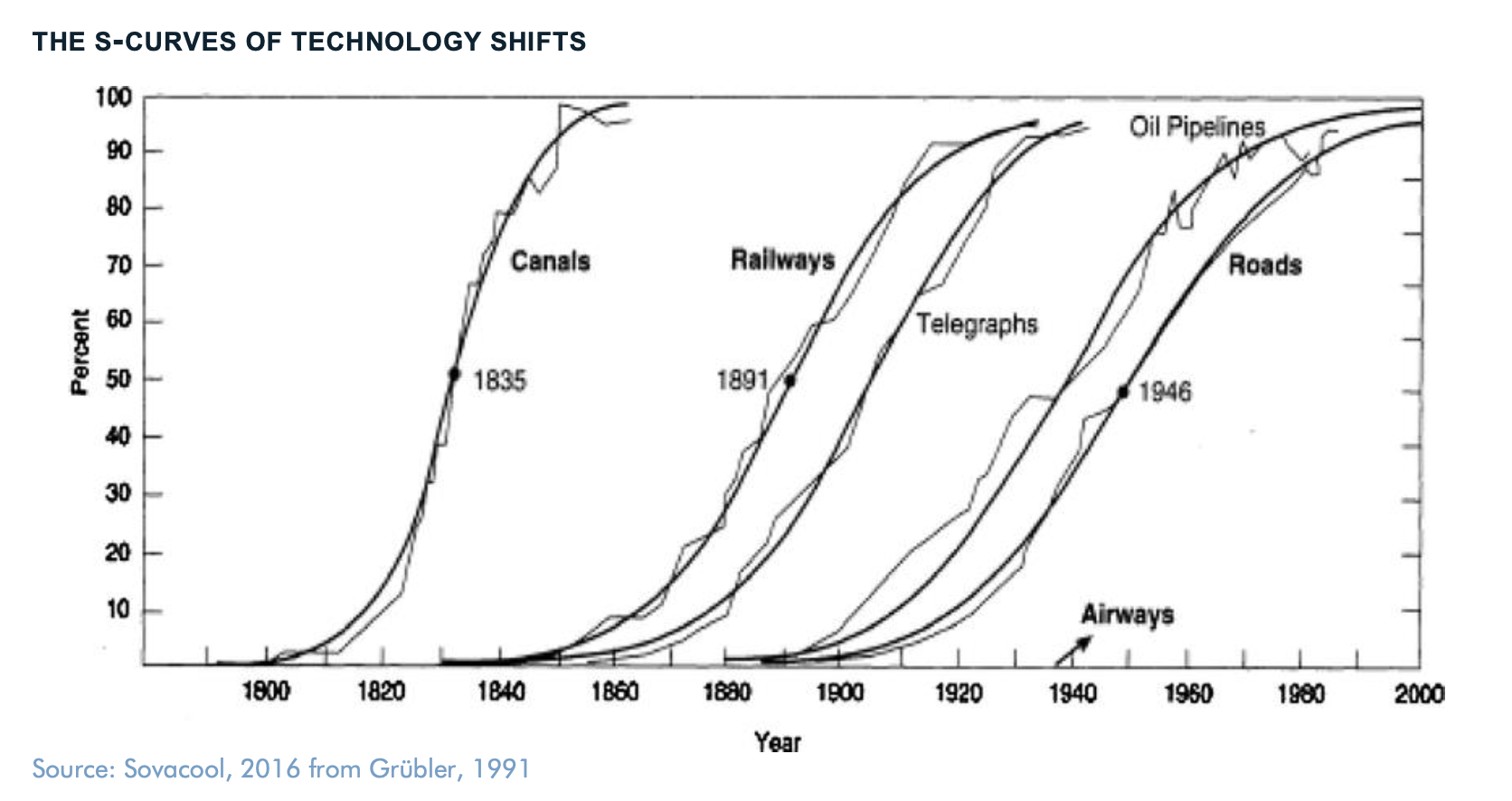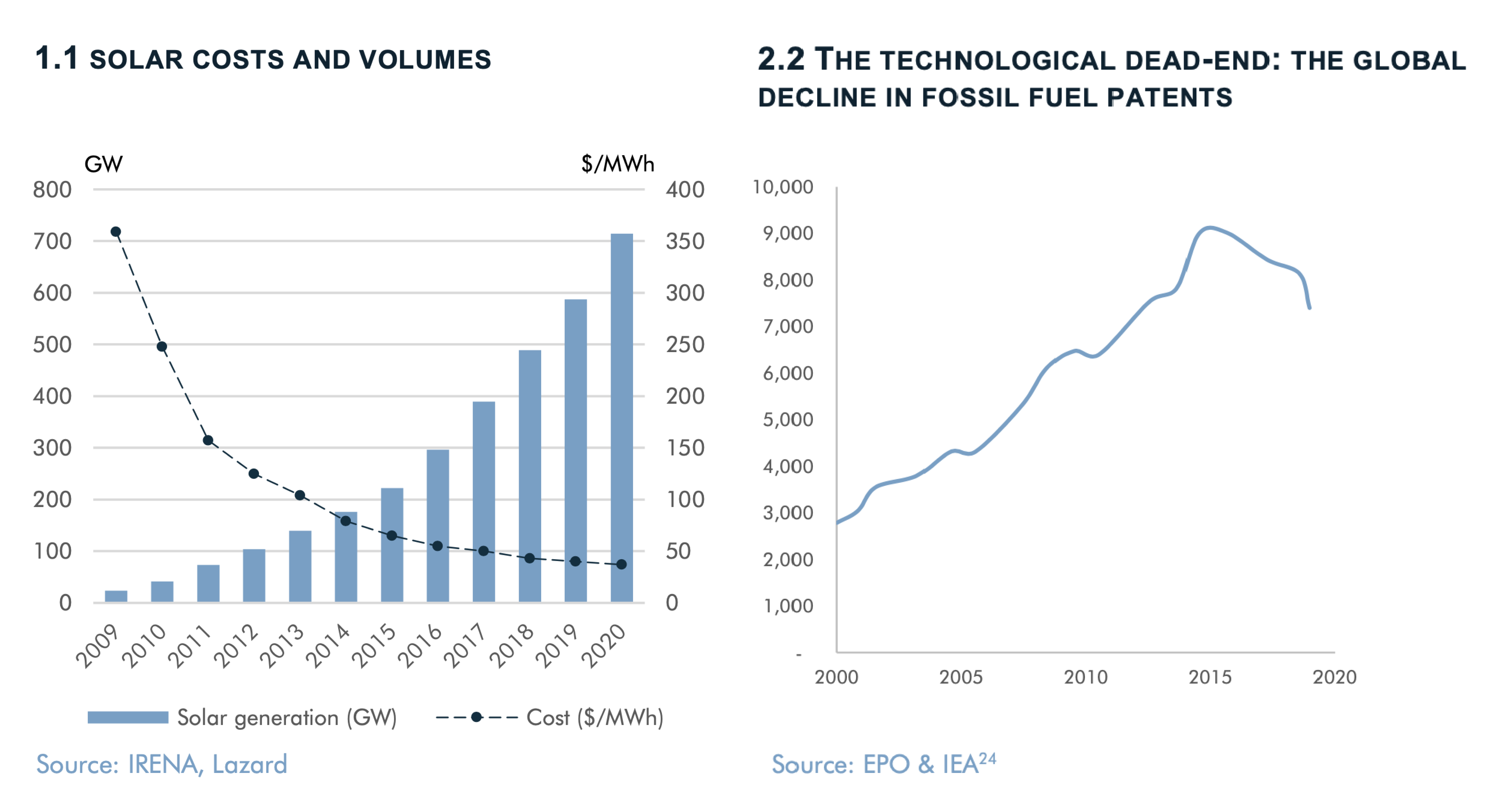Spiralling disruption: feedback loops in the energy transition
- Renewable Energy
- Renewable Power
- Transportation Efficiency
- Industries & Services
- Onshore Wind
- Solar Photovoltaic
This is the decade that reinforcing feedback loops (or spirals) are set to transform the global energy system. Feedback loops are when the effect comes back around to become the cause. When an increase in “A” leads to an increase in “B” which then comes back around to further increase “A”. This is a self-accelerating, self-reinforcing dynamic that can lead to very disruptive change.
These feedback loops and tipping dynamics are central to climate change. For example, as the planet warms, so ice melts, which then leads to less light reflection and thus more warming. The result of feedback of this kind is that the world’s temperature rises in a non-linear fashion. The human cost associated with each fraction of a degree is also not linear: the impact of moving from 0.9 to 1 °C above pre-industrial levels is not the same as moving from 1.9 to 2.0 °C — as the IPCC’s most recent publication emphasises. However, feedback loops and non-linear dynamics are not only central to understanding the nature and severity of this crisis, they are also critical to navigating a path out of it.
The only way we will outpace the feedback loops of nature is if we trigger faster feedback loops in human systems. That immediately encourages us to bring the ideas of tipping points and non-linearity into the heart of our thinking about economic change and mitigation strategies. However, the thinking of most energy forecasters, economists and investors is still very linear and siloed.
Thinking in terms of feedback loops is not only important for those seeking to accelerate change, it is necessary for anyone who simply wants to anticipate the impact of the disruption ahead. In Carbon Tracker’s latest report, Spiralling Disruption, we look at the feedback loops driving a rapid transformation of the global energy system.

In the report, we identify fourteen virtuous and vicious feedback loops across seven domains: costs, finance, technology, expectations, society, politics and geopolitics. These spirals hit the ascending and descending systems simultaneously: renewables enjoy the virtuous spirals of ascent; fossil fuels face the vicious spirals of descent. As these spirals feed off each other and gain momentum, they give rise to the non-linear “S-curve” that is very typical of technology transitions. Technology transitions can be fast; this one may be faster as the climate imperative puts rocket fuel under the already powerful feedback loops.
The volume-cost feedback loop is well known: as renewable volumes rise, so costs fall, which then spurs more volumes. This is particularly the case for “granular” renewable technologies like solar and batteries which have persistent learning curves — with each unit deployed, the next unit gets cheaper. For every doubling of solar and lithium-ion battery deployment, costs have fallen by 28% and 18% respectively. Meanwhile, falling fossil volumes mean lower utilisation rates, which increase unit costs because lower volumes are stretched over the same fixed cost base. Globally, coal generation utilisation rates have now fallen to below 50%.
The finance feedback loop is also powerful, and even has a name popularised by George Soros, reflexivity. Finance gets excited by the growth story of technology transitions. This has a recursive, reflexive effect: as capital rushes in, so the cost of capital falls and this enables more expansion. For example, in 2020, the EV sector raised $28bn in new capital from equity markets — ten times more than it raised in previous years. Meanwhile, fossil fuels face the opposite dynamic. Finance exits the incumbents, thereby accelerating their decline. As capital flees, the cost of capital rises, and this forces incumbents to change their strategy from continuous expansion to either returning capital or reallocating it to new ventures. And financial markets tend to move very fast, especially at moments of peaking demand; half the US coal sector went bust within a couple of years of peak coal demand.

Similar dynamics are playing out across five other areas: technology (cheaper batteries enable more solar deployment); expectations (as the facts change so forecasters revise their expectations); society (more people buy electric cars when their neighbours do), politics (money and power shift to growth industries) and geopolitics (the Sputnik effect as the US embraces new energy technologies to avoid being overtaken by China).
The story of the 2020s is one of disruption as tipping points beget tipping points. The economic tipping point of price parity in one technology (e.g. renewable electricity) brings forward the economic tipping in another technology (e.g. green hydrogen) which brings forward the next technologies (e.g. clean steel). Similarly, the peak in one fossil fuel-based activity is an accelerator to the peak in the next (for example the internal combustion engine and oil demand). With peaks can come financial bandwagon effects as financial markets move in packs, particularly when it comes to technology transitions. Climatic tipping points bring more social tipping points and political change. Social tipping points further accelerate market tipping points. And at times of deep and rapid social change, the gap between values and value is financial risk: a stranded paradigm leads to vast stranded assets.
Of course, the pace of the energy transition is only a partial good news story. As noted, feedback loops are driving rapid, non-linear change in natural systems as well as human systems. In that sense, we are in a race of feedback loops. Can we trigger and accelerate tipping points in human systems to outpace those in nature, before it is too late?




